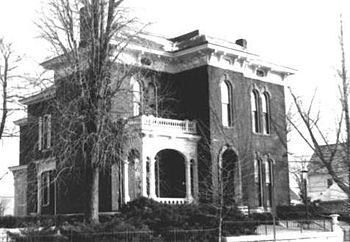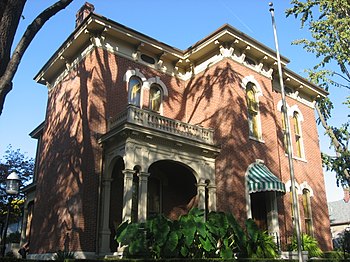| Statue of James Whitcomb Riley in Greenfield, Indiana (Photo credit: Wikipedia) |
 |
| English: Fall Creek Place, Indianapolis, Indiana, July 2008. (Photo credit: Wikipedia) |
 |
| English: Houses on the eastern side of the 300 block of N. East Street in , , . This block of East is part of the , a historic district that is listed on the . (Photo credit: Wikipedia) |
 |
| English: Front of , located at 416-418 E. Vermont Street in , , . Built in 1914, it is listed on the , and it lies within the boundaries of a Register-listed historic district, the . (Photo credit: Wikipedia) |
 |
| English: James Whitcomb Riley House / Charles L. Holstein House. James Whitcomb Riley Museum Home within the Lockerbie Square Historic District in Indianapolis. Category:Images of Indianapolis (Photo credit: Wikipedia) |
 |
| English: Front and western side of the James Whitcomb Riley House, located at 528 Lockerbie Street in , , . Built in 1872 and since converted into a museum, it was named a in 1962. (Photo credit: Wikipedia) |
Neighborhoods like
Woodruff and later Irvington
were established to give the prosperous classes from all the immigrant groups a
way to experience the park like living of a small town near the commerce of the
city. The isolation did not last long as a Victorian era closed new groups like
the “lace curtain” Irish were establishing their own unique neighborhoods with
modest homes and businesses at their previously isolated edges.
During the 60’s
many of these areas made a gallant attempt to keep their unquietcharacter, they
in some ways experienced decline but in other ways were defined and enriched
with new inhabitants. In the late seventies and early eighties many of these
great places were rediscovered for the historic architecture and famous past
residents. Today some our wholly restore and other have great urban flavor of
wealth, poverty, art, and tradition that draws a new generation of urban
families to their blocks.
Originally, the
neighborhood was called Germantown .
It was home to the numerous prosperous German Immigrants from about 1849 to
1880. The area is considered one of Indianapolis
walk able neighborhoods and soon when Indianapolis
began to prosper in the downtown area in the mid 1880’s it became one of the
more desirable neighborhoods for Indianapolis
growing Victorian middle class. It’s
most well known resident of was James Wit comb Riley who lived in the neighborhood
for two decades.
There is very
little left to indicate the German Heritage of the area here are tierces from
the period. A German Methodist church on the corner of New Jersey and Michigan
St still exists Trinity Lutheran Church on the northeast corner of Ohio and East Standee of the
largest churches built in the area was to serve the German Catholic St. Mary
built in 1857. Both churches have been demolished. St. Mary’s relocated to New Jersey St. in
1912. This are was also home to the original St. Vincent Hospital St. Vincent ’s was located on Vermont St.
James Ray-Butcher House was home to the Indiana over nor who served from 1825 to
1831 is located in the neighborhood. It was moved to the neighborhood 1977. It
is Indianapolis
oldest known house having been built in 1835. It used to occupy the space that
the Marion County
John H, Nicked was a very successful cracker make built a
very stylish home in the neighborhood in 1873. It was an Italianate home at 528 Lockerbie Street
One of the most continuously occupied Indianapolis Fountain Square Indiana Virginal Ave
The area was known as the,”tended “when the Citizens Street
Railway Company laid tracks there in the mid 1860’s. A turnabout was created at
the intersections of Virginia Ave ,
Shelby
Fountain Square
State Bank (1909),
Fountain Square Post Office (1927),
Have camp and Dirk's Grocery (1905),
Cohering & Son Warehouse (1900),
), the Frank E. Reese
Company (1904),
Wiese-Wenzel Pharmacy (1905)
, the
Sommer-Roempke Bakery (1909), the
Fountain Square Hardware Company (1912),
Horuff & Son Shoe Store (1911),
The Fountain Block Commercial
Building
The neighborhood
was also noted for it’s unique contribution to Indianapolis Theater. It boosted
the most theaters in the Indianapolis
area from 1910 to 1950. These included movie theaters, vaudeville theaters, and
amateur dramatic theaters. The area declined with the suburban growth of the
1950’s and became improvised and forgotten. The historic fountain in Fountain Square was
removed to Garfield
Park
The area has
experienced a comeback, but it still reflects of many decades of urban decline
and grit. It is becoming once again Indy entertainment micas. It has a number
of great kinky restaurants. The art flourish in the area with many galleries
and unique shops. It is home to Wheeler Arts Community and Murphy Art Center Mass Ave.
The area has experienced
a unique rise of the rival of swing dancing, very similar to the kind going on
in the lively clubs there in the 1940’s.However even then the area would not
have had the flair of more urban area because the Hoosier temperament tends to
be a little on the bland German farmer side .
James O.
Woodruff was from Auburn New York Indianapolis
In 1871
he purchased this area and opted to create a park like setting of stately
Victorian homes that would give Indianapolis
growing elite upper class a way escape the grime and grit of the increasingly
industrial Indianapolis Woodruff Place
English Tudors, Queen Anne’s, and many more
dominate the neighborhood. These homes were some of the largest built at the
time. The homes in the neighborhood date
from the 1880’s to the early 1900’s. During the twenties when some of the
larger home burned, ornate and exclusive apartment buildings were built. Many of the servants of and tradesman whoa
worked on the homes built modest cottages with ornate craftsman’s shift to
reflect some of the work done on the big homes in a small suburban area that
grew outside of Woodruff Place
Woodruff
was determined to keep the growing city out and incorporated as it’s own town. Children
who attended the public schools on the outskirts of the neighborhood paid tuition. It was the homes and families of the
neighborhood who inspired Booth Tarkington to write the <” The magnificent Amber
sons”. During the Depression many Woodruff families lost their fortunes and
were forced to take in borders or break up their very large homes into
apartments. The housing shortage of the 1940’s caused many long time families
to sell their large homes to rental groups who father canalized the magnificent
homes. Fortunately some families stayed and maintained their homes against the odes.
A very active and aggressive neighborhood association has worked for over 4
decade to preserve the unique character of Indianapolis
The neighborhood is full of young families
spending their lives restoring these old homes to their previous glory and
continuing the tradition of children playing in the fountains and neighbors
talking on porches. I raised my kids in this neighborhood as a renter. The
neighbor hood welcomes a mixture of urban singles, older couples restoring
homes in their retirement and young families looking for large homes in a great
neighborhood. Still somewhat a victim of urban decline the neighborhood is
still one of the best places to raise a family in urban Indy. There is a great diversity
in the neighborhood, but a genuine small town feel.
C. Bedford Crenshaw James Whitcomb riley house t he
Chronicle of Your State in Picturesnuttmegger woodruff place.






No comments:
Post a Comment